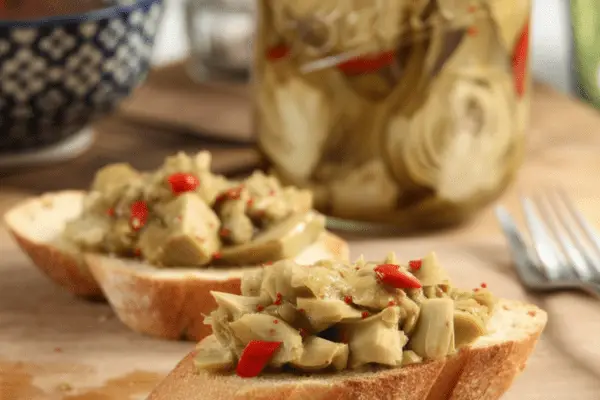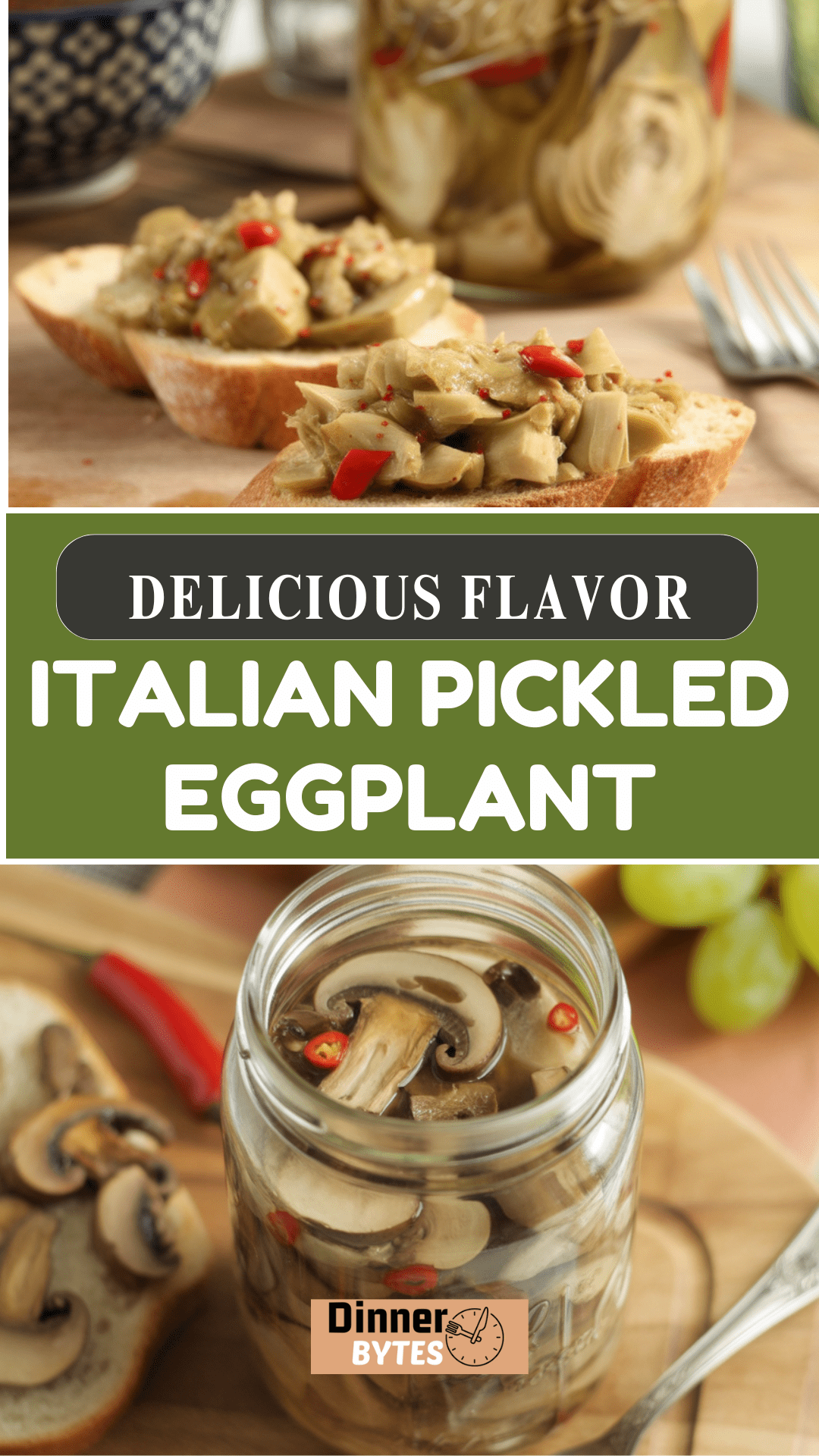If there’s one thing that truly brings me back to my Sicilian roots, it’s this classic Italian Pickled Eggplant. Just the thought of opening a jar and catching that hit of garlic, chili, and oregano instantly transports me to my mom’s kitchen. She’d always have a batch tucked away for antipasto platters or tucked into sandwiches. This recipe is my heartfelt homage to her method—no cooking, just old-school, slow, and careful preserving that rewards you with jars of pure Mediterranean sunshine.

Why You’ll Love It
This is one of those recipes that feels like a family heirloom, the kind of thing you want to pass on to the next generation. It’s ridiculously flavorful and so versatile. Add it to a crusty piece of bread with a drizzle of oil and you’ve got an instant appetizer. Stuff it into sandwiches or calzones for a punch of tangy, herby flavor. And the best part? You’re taking something humble—eggplant—and turning it into something truly special. It’s these small acts of care and time in the kitchen that remind me why I love cooking.
Ingredients
The beauty of this recipe is in its simplicity and its flexibility.
Eggplant: Firm, fresh, and preferably small to medium-sized globe eggplant. Look for ones with shiny skins and no soft spots. I like to get mine from the farmers market, and yes, I’ve followed my mom around the stalls more times than I can count hunting for the perfect ones.
Coarse salt: Essential for drawing out the bitterness and excess water.
White vinegar: Gives that bright, pickled tang.
Vegetable oil: My mom always used neutral oil so it wouldn’t solidify in the fridge.
Garlic: Freshly slivered, because there’s no substitute for that real flavor.
Dried chilis: Torn up for heat—I adjust depending on how spicy I’m feeling.
Dried oregano: Earthy, classic, and it reminds me of her pantry.
Fennel seeds: Optional, but I love the subtle licorice note they add.
When I make this with my son, I let him choose how much chili we use—he’s developing his own taste for spice, and I love that he’s part of the tradition now.
Equipment
Honestly, you don’t need anything fancy for this, which is part of the charm.
- Cutting board and sharp knife: The basics for slicing.
- Non-reactive bowls: I use my big old ceramic ones.
- Colanders: For draining all that salted liquid.
- Plates and heavy weights: Anything you have on hand—old cans, bottles of vinegar, even paving stones wrapped in plastic (yep, I’ve done that).
- Jars: I use 500 ml mason jars, but anything sterilized works.
- Fork: For really packing those eggplant strips in tight.
I love that this feels like rustic, no-fuss kitchen work. You don’t need to buy anything special, just make do with what you have.

Step by Step Instructions
This recipe spans a few days, but don’t be intimidated. Most of the time is hands-off, waiting for salt and vinegar to work their magic.
Day 1—Salting
We slice the eggplant into matchsticks and layer them with coarse salt. I always smile thinking about my mom’s kitchen counter covered in heavy objects pressing down on bowls. After 24 hours, you’ll see so much dark liquid drawn out—it’s amazing how much bitterness gets removed.
Day 2—Vinegar Soak
The next day, drain the eggplant, weigh it down again to squeeze out more liquid, then soak it in vinegar for another 24 hours. My kitchen always smells so sharp and vinegary on this day—it’s the unmistakable scent of pickling season.
Day 3—Packing the Jars
Now comes the fun part. After draining and squeezing every last drop out, you toss the eggplant with oil, garlic, chili, oregano, and fennel. I always taste a little at this stage (even though it’s pretty sharp) because I can’t help it. Then it’s into the jars, packing it down with a fork so it’s nice and tight. Top with oil, seal, and let the magic happen.
Storage
This part feels so nostalgic to me—lining jars on a shelf, knowing they’re little treasures you can crack open all year.
- Store in a cool, dark place. I keep mine in the fridge, where they last beautifully for weeks.
- Once opened, top with extra oil to keep them covered and use within 2–3 weeks.
- If the big 500 ml jars feel too much, use smaller ones. I sometimes split them into 250 ml jars for easy gifting or smaller batches.
I don’t bother with water-bath canning for these—it’s not recommended for oil-based pickles anyway.
To Serve
This is where this recipe shines.
- I love to set it out as part of an antipasto platter with crusty bread, cheeses, olives, and cured meats.
- My absolute favorite: on a toasted sausage panini with melty provolone.
- It’s incredible in stuffed pizzas, calzones, or even tossed through a salad for a burst of briny flavor.
I can’t count the number of times my son has grabbed a jar from the fridge to layer into his sandwich—watching him enjoy something we made together makes all the work worth it.

Tips and Suggestions
- Always use the freshest eggplant you can find—it makes all the difference.
- Vary the herbs: mint, basil, parsley—make it your own.
- Don’t rush the draining steps. The more liquid you get out, the better the final texture.
- Taste as you go. Want it spicier? Add more chili. More garlicky? Go for it.
- If you’re giving these as gifts (I do every year), use smaller jars—they look so charming tied with a simple ribbon.
Final Thought
I know this recipe takes a few days, but that’s what makes it so special. It’s slow food at its best—time spent salting, pressing, tasting, packing. It’s the kind of old-world kitchen work that connects us to our families and traditions. Every time I open a jar, I feel like my mom is there with me, reminding me to taste, to be patient, to enjoy the process. I hope it brings a little bit of that warmth to your kitchen too.
Italian Pickled Eggplant

If there’s one thing that truly brings me back to my Sicilian roots, it’s this classic Italian Pickled Eggplant.
Ingredients
- 5 kg eggplant (or 11 lbs) I used 8 of the common globe variety
- 1 cup coarse salt
- 3 cups white vinegar
- 3 cups vegetable oil or any other neutral flavored oil such as sunflower or canola, plus more for topping jars
- 3 garlic cloves slivered
- 1 -2 dried hot chilis or more according to taste
- 2 tablespoon dry oregano
- 2 teaspoon fennel seeds
Instructions
Day 1 - Salt the Eggplant
- Start by washing and drying the eggplant well. Remove some of the peel—either completely or just in strips, depending on your preference.
- Slice the eggplants into 1 cm rounds and then into ¾ cm matchsticks.
- Place the eggplant in two large non-reactive bowls, layering with coarse salt as you go.
- Press down the eggplant by placing a dinner plate over the layers and weigh it down with something heavy, like a can or a bottle, or even a paving stone covered in a plastic bag.
- Let it sit on the counter for 24 hours. After a few hours, you may want to switch to a salad plate to ensure the weight presses down properly.
- After 24 hours, you’ll notice that a dark water has surrounded the eggplant, and the volume has reduced.
- This is the result of the salt drawing out the bitter juices. Drain the eggplant in a colander, then weigh it down again for 2-3 hours to press out as much water as possible.
- Next, transfer the eggplant back to the bowls, add the white vinegar, dividing it evenly between the two bowls. Press it down again and leave it to sit for another 24 hours.
Day 2 - Jar and Store
- Sterilize your jars and lids. I used three 500 ml jars for this recipe.
- Drain the eggplant again, pressing it down once more for 2-3 hours to get rid of any remaining vinegar.
- Squeeze out any excess liquid by hand, as you'll be surprised at how much more comes out.
- Once drained, toss the eggplant with vegetable oil, slivered garlic, torn dried chili pepper, oregano, and fennel seeds, dividing the ingredients evenly between the bowls.
- Drizzle a little oil at the bottom of each jar, then pack the eggplant strips tightly into the jars using a fork.
- Press down firmly to ensure it’s packed as tightly as possible. Leave about 2.5 cm of space at the top of the jar.
- Pour in enough oil to cover the eggplant, but be careful not to let the oil touch the lid. Seal the jars loosely for now.
- After a few hours, check to see if the eggplant has absorbed more oil. If it has, top up with extra oil, then screw the lids on tightly.
Notes
- You can use any variety of eggplant for this recipe, just make sure it’s fresh and firm, not wrinkled. You can also experiment with different flavorings like mint, basil, or parsley.
- While my family uses vegetable oil because it remains liquid in the fridge, you can use olive oil if preferred. However, be aware that olive oil may solidify when refrigerated.
Nutrition Information
Yield
3Serving Size
1Amount Per Serving Calories 2068Total Fat 223gSaturated Fat 34gTrans Fat 2gUnsaturated Fat 179gCholesterol 0mgSodium 37741mgCarbohydrates 13gFiber 3gSugar 6gProtein 3g
dinnerbytes.com, occasionally offers nutritional information for recipes contained on this site. This information is provided as a courtesy and is an estimate only. This information comes from online calculators. Although dinnerbytes.com attempts to provide accurate nutritional information, these figures are only estimates.







